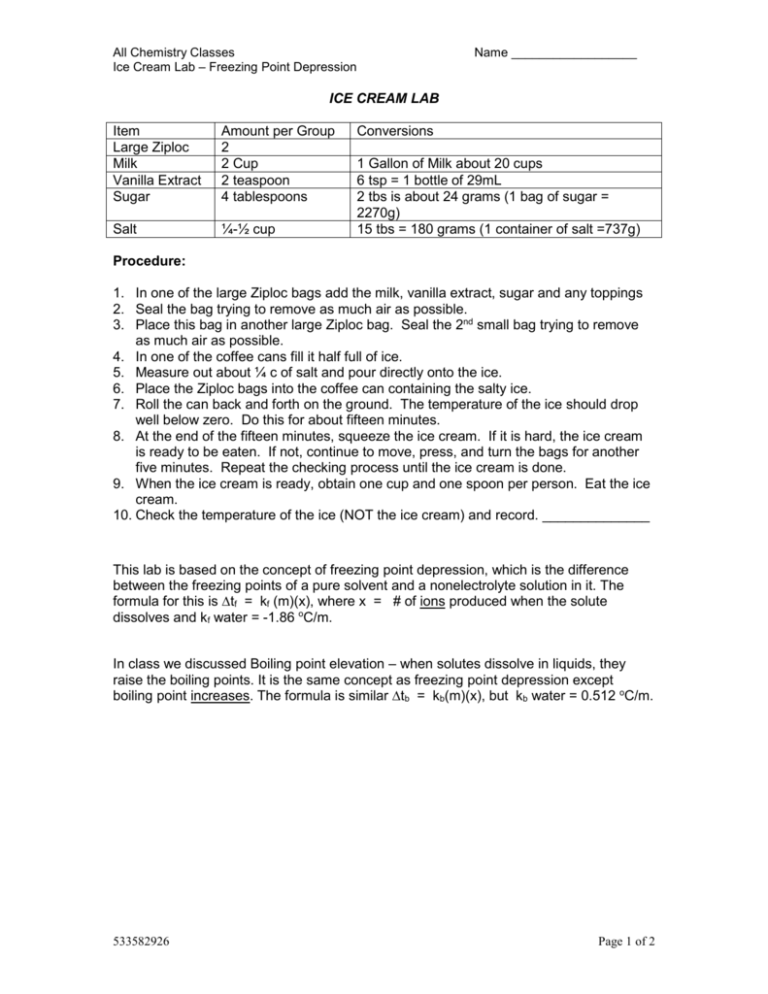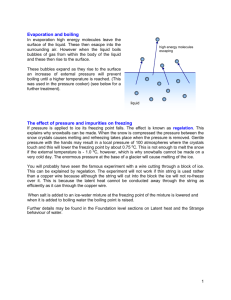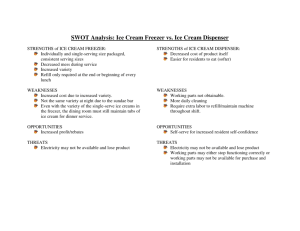ICE CREAM LAB
advertisement

All Chemistry Classes Ice Cream Lab – Freezing Point Depression Name __________________ ICE CREAM LAB Item Large Ziploc Milk Vanilla Extract Sugar Amount per Group 2 2 Cup 2 teaspoon 4 tablespoons Salt ¼-½ cup Conversions 1 Gallon of Milk about 20 cups 6 tsp = 1 bottle of 29mL 2 tbs is about 24 grams (1 bag of sugar = 2270g) 15 tbs = 180 grams (1 container of salt =737g) Procedure: 1. In one of the large Ziploc bags add the milk, vanilla extract, sugar and any toppings 2. Seal the bag trying to remove as much air as possible. 3. Place this bag in another large Ziploc bag. Seal the 2nd small bag trying to remove as much air as possible. 4. In one of the coffee cans fill it half full of ice. 5. Measure out about ¼ c of salt and pour directly onto the ice. 6. Place the Ziploc bags into the coffee can containing the salty ice. 7. Roll the can back and forth on the ground. The temperature of the ice should drop well below zero. Do this for about fifteen minutes. 8. At the end of the fifteen minutes, squeeze the ice cream. If it is hard, the ice cream is ready to be eaten. If not, continue to move, press, and turn the bags for another five minutes. Repeat the checking process until the ice cream is done. 9. When the ice cream is ready, obtain one cup and one spoon per person. Eat the ice cream. 10. Check the temperature of the ice (NOT the ice cream) and record. ______________ This lab is based on the concept of freezing point depression, which is the difference between the freezing points of a pure solvent and a nonelectrolyte solution in it. The formula for this is ∆tf = kf (m)(x), where x = # of ions produced when the solute dissolves and kf water = -1.86 oC/m. In class we discussed Boiling point elevation – when solutes dissolve in liquids, they raise the boiling points. It is the same concept as freezing point depression except boiling point increases. The formula is similar ∆tb = kb(m)(x), but kb water = 0.512 oC/m. 533582926 Page 1 of 2 All Chemistry Classes Ice Cream Lab – Freezing Point Depression Name __________________ Perform the calculations below for the freezing point depression and boiling point elevation of the following Non-electrolytes and electrolytes. In all problems, use x = 1. Calculations: Show all work! 1. NON-ELECTROLYTES in solution: a. 10.0 g urea (CH4N2O) in 125. g water b. 27.6 g glucose (C6H1206) in 200. g water 2. What are the new freezing points and boiling points of the solutions in a-b above? 3. ELECTROLYTES in solution: a. 18.0g MgCl2 250. g water b 80.0 gNH4 100. g water 4. What are the new freezing points and boiling points of the solutions in in a-b above? 533582926 Page 2 of 2






